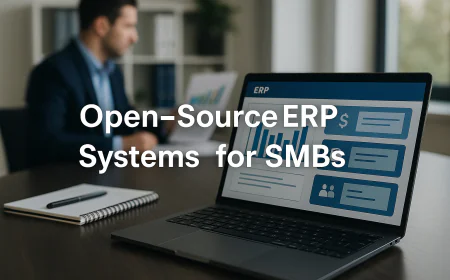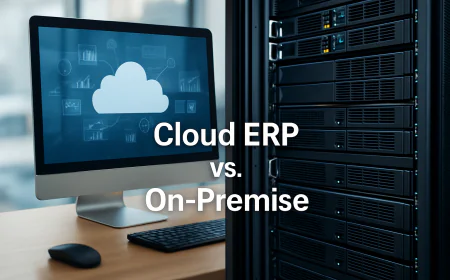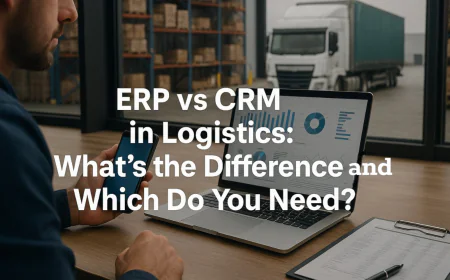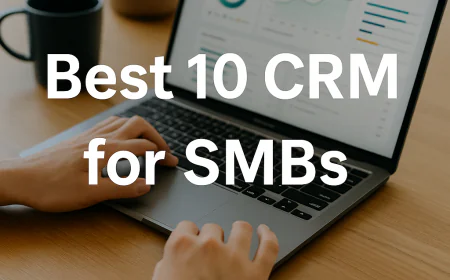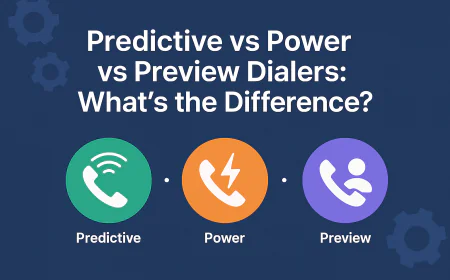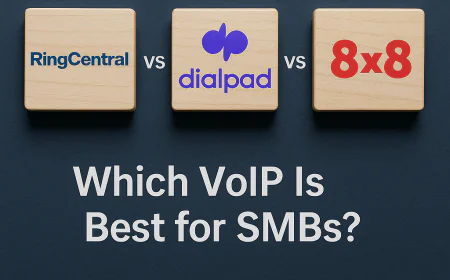What Is a Virtual Call Center? Benefits & Setup Guide
Learn what a virtual call center is, how it works, key pros and cons, and how to quickly set one up for your remote or hybrid business team.
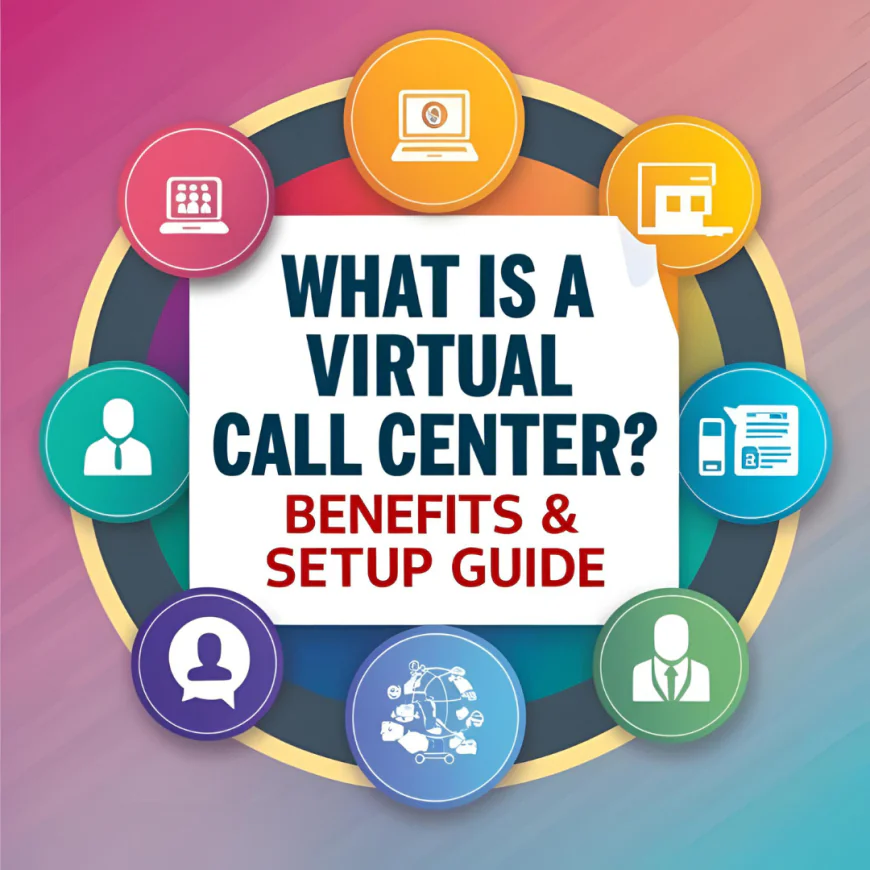
Table of Contents
-
1️⃣ What Is a Virtual Call Center?
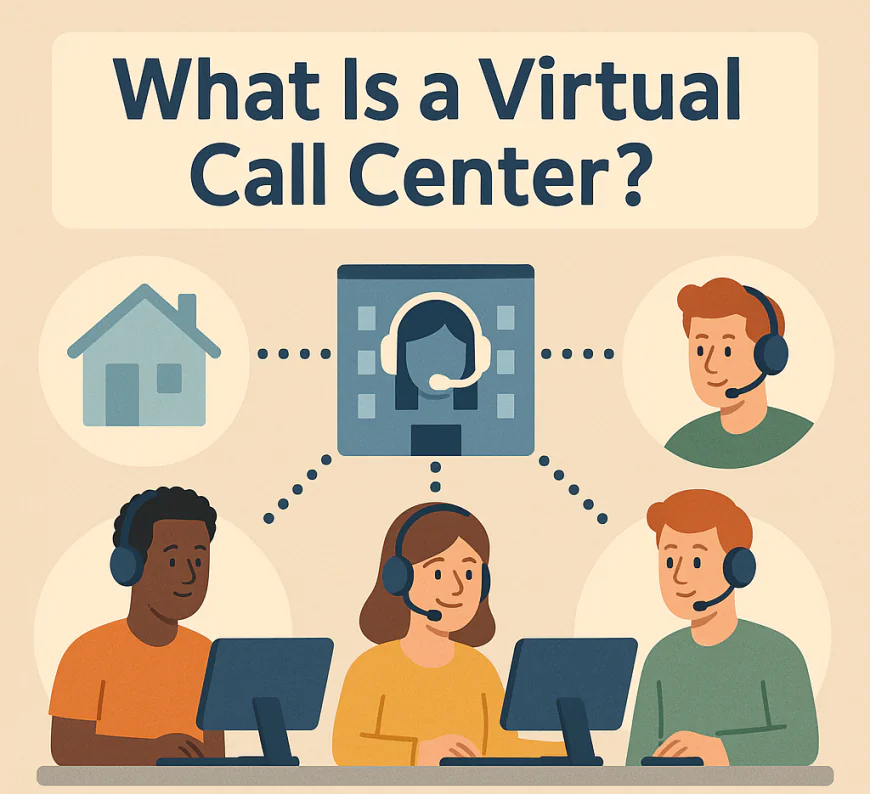
A virtual call center is a customer support or sales operation where agents handle calls, chats, or other communication channels from remote locations, rather than being physically present in a centralized office.
Unlike traditional call centers—which rely on on-premise hardware, servers, and in-person supervision—virtual call centers run entirely online, often using cloud-based software to manage inbound and outbound communication.
This model is increasingly used by small businesses, startups, SaaS companies, and global teams who want to reduce overhead while staying flexible and scalable.
🧠 Key Characteristics of a Virtual Call Center
-
✅ Cloud-based Infrastructure: Runs entirely via the internet — no physical PBX or in-house servers needed.
-
✅ Remote Workforce: Agents can work from anywhere with a stable internet connection.
-
✅ Scalable and Flexible: Easily scale up or down as business needs change — ideal for seasonal teams.
-
✅ Multi-channel Support: Many platforms also support chat, SMS, social media, and email, not just voice.
-
✅ CRM & Tool Integrations: Virtual call center software usually integrates with CRMs, helpdesks, and automation tools like HubSpot, Salesforce, or Zoho.
🤔 Is a Virtual Call Center the Same as a Cloud Call Center?
The terms are often used interchangeably, but here’s the nuance:
-
A cloud call center refers specifically to the technology stack — the cloud infrastructure powering call handling.
-
A virtual call center refers to the operational model — how agents are distributed and work remotely.
✅ In most modern use cases, a virtual call center is powered by cloud call center technology.
🆚 Virtual Call Center vs Traditional Call Center
📍 Location
Traditional Call Center: Agents work on-site in a centralized office.
Virtual Call Center: Agents work remotely from anywhere with internet access.💸 Setup Cost
Traditional Call Center: High — includes office rent, phone servers, hardware, and IT support.
Virtual Call Center: Low — uses cloud-based tools with minimal upfront investment.📈 Scalability
Traditional Call Center: Limited — tied to physical infrastructure and hiring locally.
Virtual Call Center: Easily scalable — hire agents globally and increase capacity instantly.🕒 Flexibility
Traditional Call Center: Fixed hours, often in a single time zone.
Virtual Call Center: Supports global agents and flexible shift scheduling.🧰 Technology
Traditional Call Center: On-premise equipment (PBX, SIP trunks, etc.).
Virtual Call Center: Cloud-hosted VoIP platforms and browser-based interfaces.🔐 Security
Traditional Call Center: Controlled locally through internal IT systems.
Virtual Call Center: Relies on secure cloud providers (SOC 2, GDPR, HIPAA compliant).
💬 Do Virtual Call Centers Only Handle Voice Calls?
No. Most modern virtual call centers are omnichannel, meaning they allow agents to:
-
Make and receive voice calls
-
Manage live chats and chatbots
-
Respond to emails
-
Interact via SMS or WhatsApp
-
Engage on social media platforms
This makes them ideal for modern customer expectations, especially in eCommerce, SaaS, and tech support environments.
🏢 Are Virtual Call Centers Only for Remote Teams?
Not at all. While virtual call centers are perfect for fully remote teams, many businesses use them in:
-
Hybrid teams (some agents remote, some in-office)
-
Multi-location businesses that want centralized reporting
-
Outsourced operations (e.g., BPOs)
-
Global customer service models with 24/7 coverage across time zones
💡 Quick Summary
A virtual call center is a flexible, cloud-powered setup where agents work remotely using online software to handle customer interactions across channels. It’s cost-effective, scalable, and ideal for modern businesses that don’t want to be tied to a physical office.
-
-
2️⃣ How Does a Virtual Call Center Work?
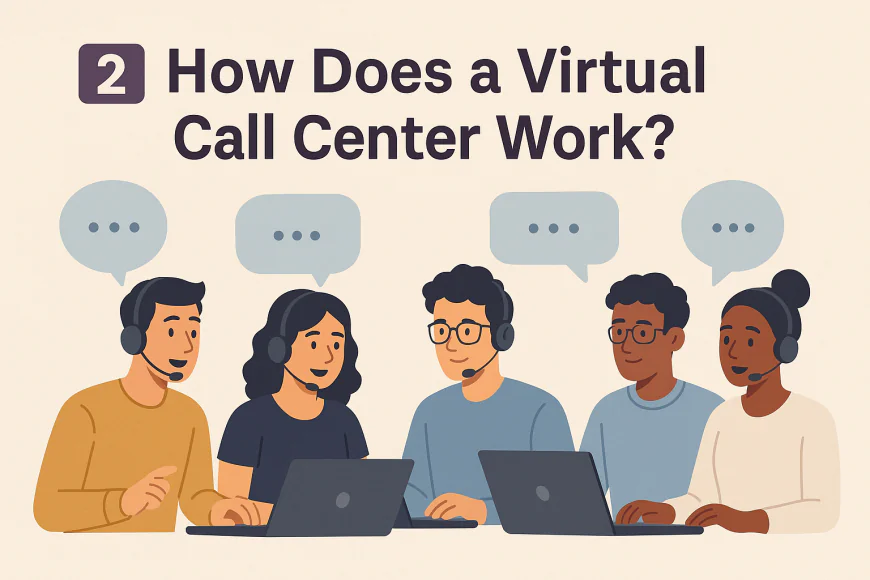
A virtual call center works by connecting remote agents to a centralized, cloud-based platform where they can manage inbound and outbound customer interactions — all from their laptop or browser, anywhere in the world.
Everything runs through the internet. There are no desk phones, on-site servers, or landlines. Calls are routed via VoIP (Voice over Internet Protocol), and communication is managed using call center software that lives entirely in the cloud.
🧩 Core Components That Make It Work
-
Cloud Call Center Software
This is the heart of the virtual call center. It’s where agents:-
Receive inbound calls (via IVR, ACD, or direct routing)
-
Make outbound calls using power or predictive dialers
-
Handle chat, email, SMS, or social messages
-
View scripts, call notes, and CRM data
-
Log interactions automatically
-
-
VoIP (Voice over IP)
Voice calls are transmitted digitally over the internet, not phone lines. This enables:-
Crystal-clear call quality
-
Lower costs
-
Global connectivity with local numbers
-
-
CRM + Help Desk Integrations
Virtual call centers typically sync with CRMs like HubSpot, Zoho, or Salesforce, allowing agents to:-
View customer data in real time
-
Log call outcomes
-
Trigger automations or follow-ups
-
-
Remote Agent Workstations
Agents log in from any device (usually a laptop or desktop) using:-
A browser or desktop app
-
A headset with a mic
-
A strong internet connection (min. 10 Mbps recommended)
-
-
Real-Time Supervision Tools
Supervisors can:-
Listen to live calls
-
Whisper to agents without the customer hearing
-
View agent activity dashboards
-
Track KPIs like call volume, wait times, and CSAT
-
🔄 Step-by-Step: What a Typical Call Flow Looks Like
-
A customer calls your support or sales number.
-
The call is routed via your cloud provider’s IVR menu.
-
Based on logic (e.g., language, department, time), the call is assigned to a remote agent.
-
The agent answers the call using their browser app and headset.
-
During the call, the agent sees the customer’s CRM history.
-
Notes, tags, or follow-ups are logged and synced automatically.
The same flow applies to chat, SMS, or even social media support — all within one unified interface.
🌍 Can Agents Be in Different Time Zones?
Yes — this is one of the biggest advantages. With a virtual call center:
-
You can provide 24/7 global support without physically expanding your office.
-
Use "follow the sun" scheduling by hiring agents across continents.
-
Customers always get help from a live human, even outside business hours.
💼 What Do Businesses Need to Set One Up?
You don’t need any hardware or telecom contracts. At a minimum, you’ll need:
-
A cloud call center platform (like Aircall, CloudTalk, or JustCall)
-
A CRM or help desk to integrate with
-
Remote agents (in-house or outsourced)
-
Headsets + reliable Wi-Fi (no less than 10 Mbps down/2 Mbps up)
-
Optional: training materials, scripts, or SOPs
⚡ Most virtual call centers can be fully set up in under a day — sometimes in under an hour.
🧠 Smart Features That Power Modern Virtual Centers
Modern platforms include:
-
Automatic Call Distribution (ACD)
-
Interactive Voice Response (IVR)
-
Call recording & analytics
-
AI-powered coaching
-
Live chat routing
-
Custom workflows
These are all configured via software, not hardware — making it easy to tweak settings without calling IT.
-
-
3️⃣ Pros and Cons of Virtual Call Centers
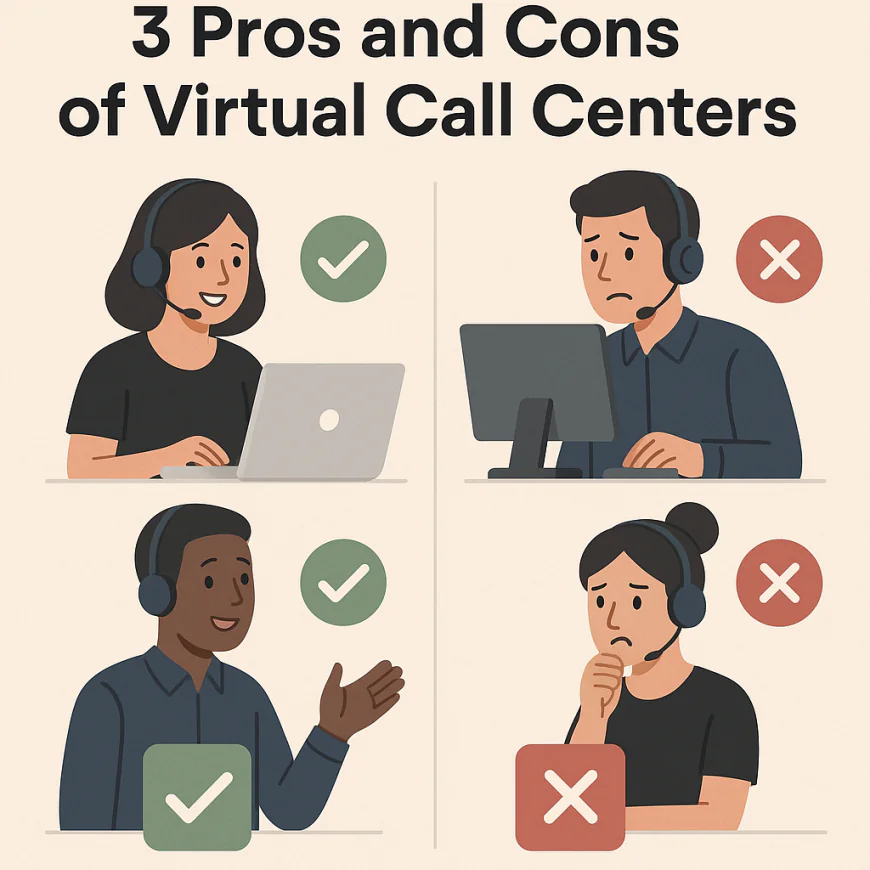
Understanding the advantages and disadvantages of a virtual call center is critical before making the shift — especially for SMBs, remote teams, and IT decision-makers evaluating scalability and cost-efficiency.
Let’s break down the real-world pros and cons, including operational impact, security, and agent performance.
✅ Major Benefits of Virtual Call Centers
1. Lower Upfront Costs
Unlike traditional call centers, you don’t need:-
Office space or physical phone systems
-
PBX hardware or on-prem servers
-
IT installation fees
All you need is a subscription to a cloud-based platform and some basic equipment (headsets, internet). You can launch with zero capital expenditure (CapEx).
2. Rapid, Global Scalability
Virtual systems grow with you:-
Add or remove agents instantly
-
Hire from any country or time zone
-
No need to relocate or expand office space
Perfect for seasonal businesses, fast-growth startups, or companies with global customers.
3. More Flexibility for Agents
Remote call center agents can:-
Work from home (or anywhere)
-
Set flexible hours
-
Balance personal schedules
This improves morale and reduces turnover — which is one of the biggest cost factors in support and sales teams.
4. Built-in Analytics & Reporting
Modern virtual call center software gives you:-
Real-time dashboards
-
KPIs like call duration, abandonment rate, CSAT
-
Historical performance trends
You get instant visibility into team productivity without manual spreadsheets.
5. Easier Maintenance & Updates
You’ll never have to:-
Call IT to fix a phone line
-
Replace hardware or servers
-
Wait for security patches
Everything runs in the cloud — providers handle the backend. Most updates are automated and rolled out with zero downtime.
6. Business Continuity & Disaster Recovery
Power outage at HQ? Fire in the office? It doesn’t matter.
Your agents can still operate from anywhere, and customer service stays up — even if one region goes down.
⚠️ Common Drawbacks and Challenges
1. Internet Dependence
If an agent’s Wi-Fi goes down or isn’t fast enough (less than 10 Mbps), calls may:-
Drop mid-conversation
-
Sound distorted
-
Lag or echo
✅ Solution: Most platforms recommend wired connections and minimum bandwidth specs.
2. Security & Compliance Concerns
Sensitive data (e.g., payment details, personal info) is handled in the cloud — which makes:-
SOC 2, HIPAA, GDPR compliance essential
-
End-to-end encryption and access control a must
✅ Solution: Only choose tools that clearly publish their compliance standards.
3. Supervision May Feel Distant
Managers can’t walk the floor or give live in-person feedback, which may:-
Make onboarding slower
-
Reduce quality if you lack training workflows
✅ Solution: Use platforms with:
-
Live call monitoring
-
Whisper/talk/coaching modes
-
Quality assurance dashboards
4. Distractions at Home
Some agents may struggle to stay focused without a formal office environment. Dogs, kids, and background noise can impact professionalism.✅ Solution: Set clear WFH policies and use AI-based sentiment/coaching tools that flag poor quality in real-time.
5. Onboarding & Culture Building Requires Effort
You’ll need to be proactive about:-
Building team culture remotely
-
Sharing knowledge bases, SOPs, and training guides
-
Holding virtual standups or check-ins
But once dialed in, retention and performance can rival in-office teams.
In Summary: Is a Virtual Call Center Right for You?
If you want to:
-
Cut costs
-
Hire globally
-
Launch fast
-
Maintain service 24/7
…a virtual call center is a no-brainer. But you must invest in training, policies, and top-tier software to make it successful.
-
-
4️⃣ How to Set Up a Virtual Call Center Step-by-Step

A complete, actionable guide covering everything from software and agents to compliance and launch.
This section is written for small business owners, IT managers, and CX leaders who want to set up a virtual call center from scratch — without wasting budget or making costly mistakes.
🔹 Step 1: Define Your Call Center’s Purpose & Requirements
Before you pick a single tool or hire your first agent, clarify:
-
What type of call center will you run?
-
Inbound support?
-
Outbound sales?
-
Blended?
-
-
How many agents will you start with?
-
Just 1–5 part-time reps?
-
20+ across multiple time zones?
-
-
What channels will you support?
-
Just voice?
-
Or voice + SMS + live chat + WhatsApp?
-
-
What’s your budget per month per agent?
Most tools range from $15–$75/user/month depending on features.
💡 Why it matters: These choices affect the software, hardware, workflows, and even your legal setup.
🔹 Step 2: Choose the Right Virtual Call Center Software
This is your central operating system — all calls, agent activity, routing, analytics, and integrations live here.
✅ Your software must include:
-
VoIP calling (with local/global numbers)
-
IVR (Interactive Voice Response) menus
-
Call queueing + routing rules
-
Call recording & storage
-
Live dashboards + analytics
-
Role-based access + compliance
🎯 Optional but powerful extras:
-
AI coaching / transcription
-
Power dialers for sales teams
-
Built-in CRM or CRM integrations
-
Call whisper/barge-in
-
SMS, chat, or omnichannel tools
🔗 Popular providers include:
💡 Pro tip: Start with a free trial or month-to-month before locking into a yearly plan.
🔹 Step 3: Secure Phone Numbers & Configure Call Flows
Once you’ve signed up for your software, it’s time to configure:
-
Phone numbers
-
Buy toll-free or local numbers for each country or region you serve.
-
Many tools let you instantly assign numbers to agents or teams.
-
-
IVR menus
-
Create a simple flow: “Press 1 for Sales, 2 for Support, 3 for Billing”
-
Keep it short and route to the right queue.
-
-
Call routing
-
Set rules like round-robin, skill-based, or time-based routing.
-
Build overflow routing (e.g., route to backup agent if first is unavailable).
-
-
Business hours
-
Define when agents are active.
-
Set up after-hours voicemail or automatic callbacks.
-
🔹 Step 4: Equip Your Agents (Tech + Environment)
Every virtual agent needs:
-
A reliable laptop or desktop (minimum 8GB RAM, updated OS)
-
Noise-canceling headset (wired USB preferred)
-
Stable internet (minimum 10 Mbps download, 5 Mbps upload)
-
A quiet, distraction-free workspace
(home office is ideal, but co-working spaces can also work)
💡 Advanced tools like Dialpad and Aircall also offer desktop/mobile apps, so reps can answer calls on the go — just ensure mobile bandwidth is stable.
🔹 Step 5: Hire & Train Remote Agents
Hiring remotely means your talent pool is global — but it also requires a process.
🛠️ Hiring tips:
-
Look for past call center or customer-facing experience.
-
Use tools like Indeed, We Work Remotely, or niche call center hiring boards.
-
Test candidates with mock calls.
🎓 Training must cover:
-
Product knowledge
-
Call handling scripts
-
Tool walkthroughs (CRM + phone system)
-
Compliance and customer data protection
💡 Pro tip: Use screen recordings, onboarding videos, and SOP docs. Build a shared knowledge base with FAQs and escalation paths.
🔹 Step 6: Integrate with Your CRM & Business Tools
To avoid duplicate work and lost context, your call center tool must connect to your:
-
CRM (e.g., HubSpot, Zoho, Salesforce)
-
Helpdesk (e.g., Zendesk, Freshdesk)
-
Calendar (for callbacks or appointments)
-
Internal chat (Slack, MS Teams)
📌 Look for native integrations or Zapier/API if native isn’t available.
💡 Best-in-class platforms auto-log every call in your CRM, record notes, and sync call recordings — so agents never have to “double enter” info.
🔹 Step 7: Monitor Performance, QA, and Compliance
Once live, keep a close eye on:
-
Call volume and wait times
-
Agent availability and call duration
-
CSAT (Customer Satisfaction) surveys
-
Missed call reasons
-
Quality Assurance (QA) scorecards
💡 Most tools offer built-in dashboards — or you can export data to Google Sheets/Data Studio for custom views.
🎯 Also handle compliance:
-
Set call recording disclaimers.
-
Use role-based access controls.
-
Ensure data handling follows GDPR, HIPAA, or SOC 2 standards (based on your industry).
🔹 Step 8: Launch & Continuously Optimize
Once live:
-
Test your IVR flows and routing rules
-
Do internal test calls
-
Monitor performance daily for the first week
🛠️ Ongoing optimization ideas:
-
Use AI sentiment analysis to flag at-risk customers
-
Rotate scripts based on conversion rates
-
Review recordings weekly and coach agents with specific feedback
-
-
5️⃣ Best Software Tools for Virtual Call Centers
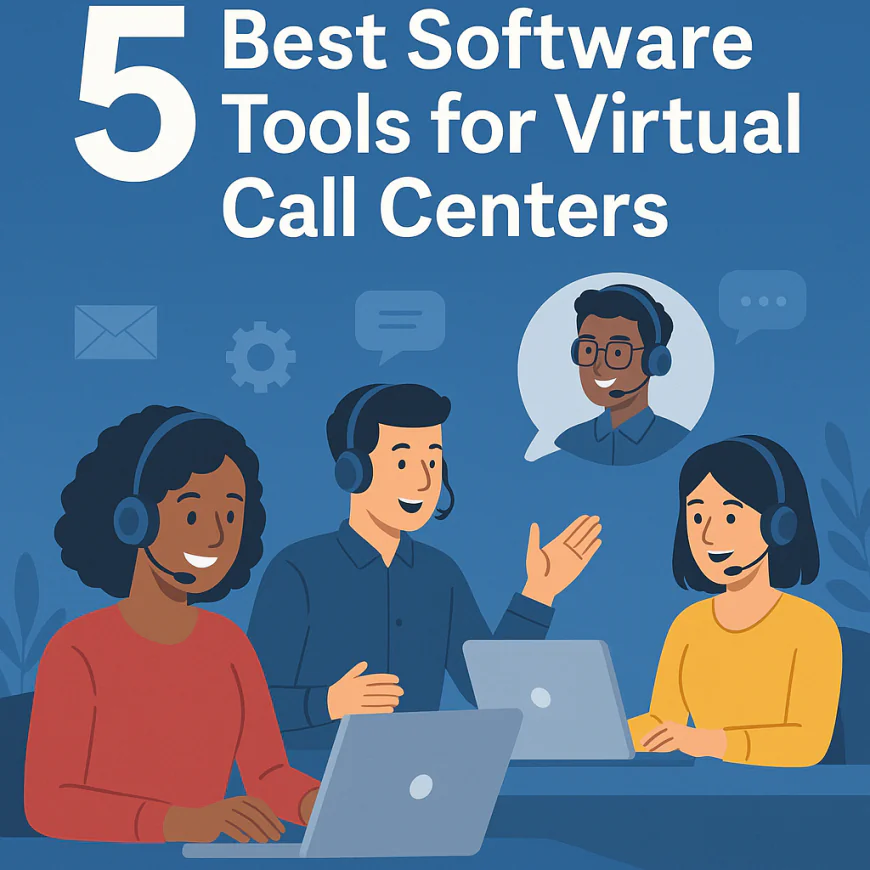
The top cloud-based platforms for running a virtual call center smoothly — with links to each official website.
This section helps you choose the right software for your virtual call center based on your team size, use case (sales vs support), integrations, and budget. Each tool includes:
-
Who it’s best for
-
Core features
-
Pros and cons
-
CRM integrations
-
Starting price
-
🔗 Direct link to official site
🔹 1. Aircall – Best All-Around for SMBs
Why it stands out:
Aircall is built for growing support and sales teams. It combines an intuitive interface with powerful CRM integrations and real-time call features — no IT team needed.Key features:
-
Click-to-dial, IVR, live call routing
-
Native integrations with HubSpot, Salesforce, Zoho, Intercom
-
Real-time coaching (whisper, barge)
-
Shared team inbox and call notes
-
Desktop and mobile apps
Pros:
✅ Easiest setup on the market
✅ Seamless CRM sync
✅ Transparent pricing, no hidden feesCons:
⚠️ Limited omnichannel (no built-in live chat or WhatsApp)
⚠️ Not built for high-volume enterprise contact centersBest for:
SMBs with remote support or inside sales teams that need plug-and-play setup.Starting price: $30/user/month
🔗 Visit Aircall Official Website
🔹 2. Nextiva – Most Feature-Rich for Growing Teams
Why it stands out:
Nextiva combines VoIP, team collaboration, contact center features, and even CRM into one platform — perfect for businesses scaling fast.Key features:
-
VoIP + built-in CRM + SMS
-
Screen pop with caller history
-
Workflow automations
-
Call analytics and reporting
-
Video meetings and chat tools
Pros:
✅ Great all-in-one stack
✅ 24/7 U.S.-based support
✅ Highly customizable call flowsCons:
⚠️ Slightly steeper learning curve
⚠️ May be overkill for teams under 5 agentsBest for:
Mid-sized teams that want one unified communications platform.Starting price: $50/user/month
🔗 Visit Nextiva Official Website
🔹 3. CloudTalk – Best for International Call Centers
Why it stands out:
CloudTalk gives you access to 160+ international phone numbers and global call quality optimization — ideal for remote teams across continents.Key features:
-
Virtual numbers in 160+ countries
-
Smart call routing + queues
-
Call tagging, analytics, call notes
-
CRM integrations: Pipedrive, Zoho, Salesforce, etc.
-
API and webhooks
Pros:
✅ Excellent for international teams
✅ Strong analytics dashboard
✅ Easy scaling up/down by userCons:
⚠️ Lacks native live chat or email support options
⚠️ No built-in CRMBest for:
Startups and SMBs with clients or reps in multiple countries.Starting price: $25/user/month
🔗 Visit CloudTalk Official Website
🔹 4. JustCall – Top Pick for Sales-Focused Teams
Why it stands out:
JustCall is designed for outbound calling and remote sales workflows. With SMS automation and dialers, it’s ideal for inside sales, lead follow-ups, and appointment setting.Key features:
-
Power dialer and call automation
-
SMS workflows + templates
-
Click-to-call from CRMs
-
Voicemail drop, call recording
-
Integrates with Zoho, Pipedrive, HubSpot, and more
Pros:
✅ Built for speed and sales outreach
✅ Fast learning curve
✅ Includes SMS + voice in one UICons:
⚠️ Not ideal for large inbound support teams
⚠️ Analytics less advanced than CloudTalk or AircallBest for:
Startups and agencies doing outbound campaigns.Starting price: $25/user/month
🔗 Visit JustCall Official Website
🔹 5. Dialpad AI Contact Center – Best AI-Powered Virtual Call Center
Why it stands out:
Dialpad brings real-time AI coaching, live transcription, and CSAT prediction into your call center. It’s perfect for teams wanting next-gen features without enterprise complexity.Key features:
-
AI-powered live call summaries
-
Agent assist and QA tools
-
Built-in call analytics
-
Video meetings and messaging
-
Integrations with Salesforce, Microsoft 365, Zendesk
Pros:
✅ Live transcriptions + AI coaching
✅ High CSAT prediction accuracy
✅ All-in-one UCaaS + CCaaS platformCons:
⚠️ Slightly higher price point
⚠️ Some AI features gated behind higher tiersBest for:
Teams prioritizing agent coaching, QA automation, and AI insights.Starting price: $60/user/month
🔗 Visit Dialpad Official Website
-
-
6️⃣ FAQs About Virtual Call Centers
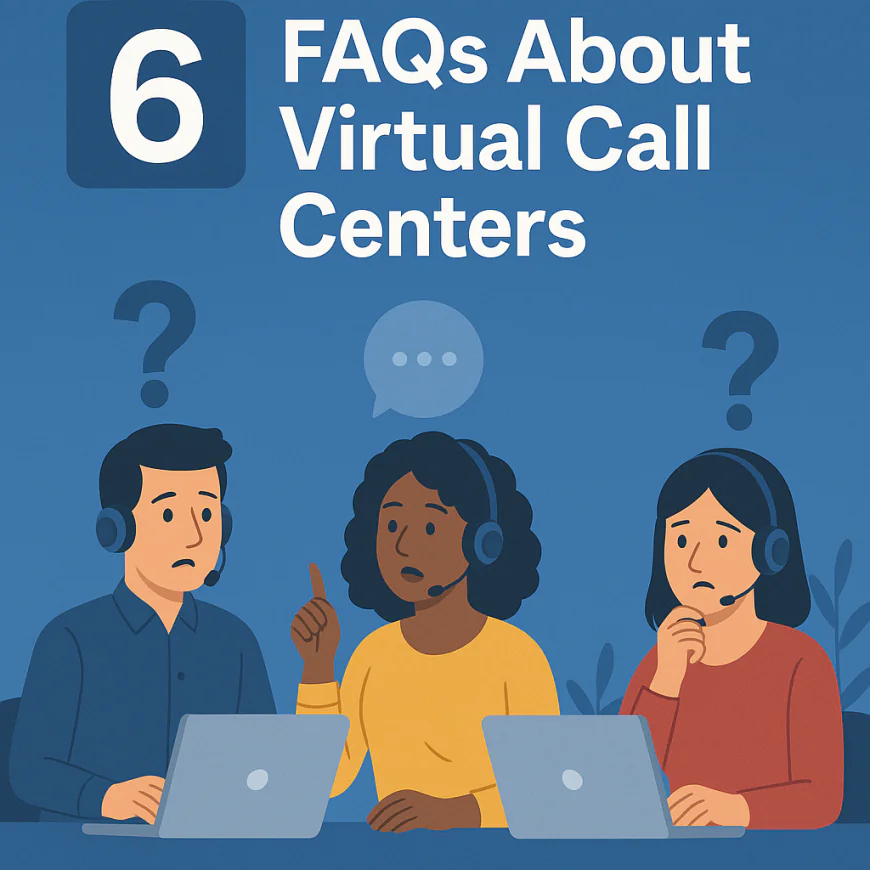
Answers to the most common — and critical — questions business owners and IT teams ask before making the switch.
➕ What’s the difference between a virtual call center and a cloud-based phone system?
A cloud-based phone system (VoIP) gives your team the ability to make and receive calls over the internet. But a virtual call center is a broader operational setup — using cloud-based phone systems plus tools like routing, IVR, queue management, CRM integration, and agent performance analytics.
In short:
-
Cloud phone system = just calling.
-
Virtual call center = full contact center functionality, remotely managed.
💰 How much does it cost to run a virtual call center?
Costs vary depending on team size and software. Here's a rough breakdown:
-
Software: $15–$60 per agent/month
-
CRM/Integrations: $0–$50 depending on plan
-
Headsets/devices: $50–$200 one-time
-
Onboarding/training: Free to $500 depending on vendor
For a 5-agent team, expect a starting monthly cost of $150–$400. That’s still significantly cheaper than the $5,000+ monthly cost of operating a traditional on-site call center.
🌐 Can I run a virtual call center with global agents?
Yes. In fact, virtual call centers are ideal for remote global teams.
To succeed:
-
Choose software that offers international virtual numbers (like CloudTalk or Aircall)
-
Set clear shift schedules across time zones
-
Use centralized tools (CRM, ticketing, Slack, etc.) for async communication
-
Monitor with live dashboards and call recordings
Most top-tier call center software supports international compliance and data protection laws like GDPR.
🔐 Is a virtual call center secure?
Yes — if you choose the right providers.
Look for platforms that offer:
-
SOC 2 compliance
-
End-to-end encryption
-
Multi-factor authentication (MFA)
-
Role-based access control
Also ensure your agents use secure Wi-Fi, updated browsers, and VPNs when needed. Most security risks arise from poor local practices, not the software itself.
🧩 What CRM tools integrate best with virtual call center platforms?
Popular CRM tools used with virtual call centers include:
-
HubSpot — seamless with Aircall, JustCall, Dialpad
-
Zoho CRM — native to Zoho Desk, integrates with CloudTalk and JustCall
-
Salesforce — integrated across Dialpad, Nextiva, Aircall, and others
-
Pipedrive — works well with CloudTalk and JustCall
-
Zendesk — excellent for inbound support teams, pairs with Nextiva and Aircall
Your CRM should support click-to-dial, screen pop, contact sync, and logging call activity automatically.
🔗 Where can I find trusted virtual call center software?
Here are direct links to some of the best tools covered in this guide:
Each of these providers offers free trials or demos, so you can test before you invest.
-
-
7️⃣ Want to Conclude More? Try These

More tests. More answers. Explore these next to conclude smarter.
These handpicked articles help you explore more angles so you can conclude with confidence.
🔄 Need Help Setting Up Your Call Center?
Looking for a comprehensive, step-by-step guide tailored for small businesses? Learn everything you need to get started in:
👉 How to Set Up a Call Center for a Small Business article
🔁 For Enterprise-Level Needs
Scaling beyond the SMB stage? If you're looking for powerful, enterprise-ready platforms with advanced routing, deep analytics, and global compliance, explore:
👉 10 Best Call Center Phone Systems for Large Enterprises🧩 For Small and Midsize Businesses
Running a small or midsize business? For flexible, cost-effective solutions designed for lean teams, check out:
👉 10 Best Call Center Phone Systems for SMBs
🔄Looking to Supercharge Your Call Center with CRM Tools?
Discover the top integrations that boost efficiency, improve customer experience, and streamline operations in:
👉 Top 10 CRM Integrations Every Call Center Should Use
🔄 Need Help Comparing Call Center Software vs Phone Systems?
Not sure which solution is right for you? Get a clear breakdown of features, differences, and use cases in:
👉 Call Center Software vs Phone System: Key Differences
🔄 Omnichannel vs Multichannel Contact Centers: Still Deciding?
Not sure which communication model fits your business best? Dive deep into real-world use cases, CX impact, and when to scale up in:
👉 Omnichannel vs Multichannel Contact Centers: Key Differences Explained
🔄 Confused About ACD, IVR, and Skills-Based Routing?
If you're not sure how call routing works — or which system your call center really needs — get a clear, jargon-free breakdown in:
👉 Call Routing Explained: ACD vs IVR vs Skills-Based Routing
🔄 Choosing a VoIP Provider But Don’t Know Where to Start?
From pricing clarity to mobile features and CRM compatibility, we’ve ranked the top contenders for growing teams in:
👉 7 Best VoIP Providers for Small Businesses
🔄 Still Using a Landline? Wondering If VoIP Is Worth the Switch?
We break down cost, reliability, scalability, and key call center features in:
👉 VoIP vs Landline: What’s Best for Call Centers? article
🔄 Stuck Between RingCentral, Dialpad, and 8x8?
We compared all three across pricing, features, reliability, and integrations — so you can skip the guesswork and pick the right VoIP for your SMB. Dive into the full breakdown:
👉 RingCentral vs Dialpad vs 8x8: Which VoIP Is Best for SMBs?
🔄 Inbound vs Outbound Call Centers: Not Sure Which You Need?
Discover the core differences, pros and cons, and best-fit tools for each model — so you can set up the right strategy from day one:
👉 Inbound vs Outbound Call Centers: Key Differences + Tools
🔄 Choosing Call Center Software? Don’t Wing It.
Step-by-step guide to choosing the best call center software for your team based on size, features, budget, and use case — expert picks included.
👉 How to Choose the Best-Fit Call Center Software
What's Your Reaction?
 Like
1
Like
1
 Dislike
0
Dislike
0
 Love
1
Love
1
 Funny
0
Funny
0
 Angry
0
Angry
0
 Sad
0
Sad
0
 Wow
1
Wow
1







